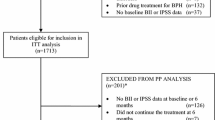Summary
Objectives
The aim of the survey was to assess physician’s behavior and the global knowledge about patient’s preferences and their psychological burden linked to lower urinary tract symptoms (LUTS) in an outpatient setting in Slovakia.
Methods
The study included 36 outpatient urological clinics. Overall, 1132 newly diagnosed LUTS patients were screened within 1 month. A total of 454 questionnaires were obtained from 459 LUTS patients with risk of progression (RP). Inclusion criteria were: age > 50 years, IPSS > 8, prostate volume ≥ 30 cm3, and PSA ≥ 1.5 to ≤ 10 ng/ml.
Results
The digital rectal examination, PSA testing, and urinalysis were used in all the centers as first visit examinations. The least frequently performed diagnostic procedure was uroflowmetry (74 %). The physician’s preferred therapy for patients with RP was standard combined treatment in (52.6 %); followed by α-blocker alone (45 %) and monotherapy with 5-α-reductase inhibitors (5-ARI) only in 3 % of all asked urologists. Patient’s mean age was 63.3 years (SD ± 7.4); baseline PSA value 2.2 ng/ml (SD + 3.2); prostate volume was 38.0 ml (SD ± 16.7 ml); Qmax was 11.5 ml/s (SD ± 4.6); and IPSS score 12.5 (SD ± 6.3). The most bothersome symptoms were nocturia (prevalence of ≥ 75 %), weak urinary stream (61 %), and retarded voiding (43 %). Patient’s expectations of treatment were rapid improvement of symptoms (36.0 %), stabilization of symptoms (35.5 %), and reduction of potential risk of surgical intervention (25.8 %).
Conclusions
Our research reflects the physician’s behavior, patient’s self-perception of the disease and therapeutic priorities in the current outpatient practice in Slovakia.




Similar content being viewed by others
References
Teillac P. Benign prostatic hyperplasia: patients perception of medical treatment and their expectations: results of French survey involving patients treated with finasteride. Therapie. 2002;57:473–83.
Hong SJ1, Rayford W, Valiquette L, et al. The importance of patient perception in the clinical assessment of benign prostatic hyperplasia and its management. BJU Int. 2005;95(1):15–9.
Kaplan S, Naslund M. Public, patient, and professional attitudes towards the diagnosis and treatment of enlarged prostate: a landmark national US survey. Int J Clin Pract. 2006;60(10):1157–65.
Emberton M, Marberger M, Rosette Jdl. Understanding patient and physician perceptions of benign prostatic hyperplasia in Europe: the prostate research on behavior and education (PROBE) survey. Int J Clin Pract. 2007;62(1):18–26.
Emberton M. Medical treatment of benign prostatic hyperplasia: physician and patient preferences and satisfaction. Int J Clin Pract. 2010;64(10):1425–35.
Parsons JK, Wilt TJ, Wang PY, et al. Osteoporotic Fractures in Men Research Group. Progression of lower urinary tract symptoms in older men: a community based study. J Urol. 2010;183(5):1915–20.
Maserejian NN, Chen S, Chiu GR, et al. Treatment status and progression or regression of lower urinary tract symptoms in a general adult population sample. J Urol. 2014;191(1):107–13.
McVary KT, Roehrborn CG, Avins AL, et al. Update on AUA guideline on the management of benign prostatic hyperplasia. J Urol. 2011;185(5):1793–803.
Madersbacher S1, Alivizatos G, Nordling J, et al. EAU 2004 guidelines on assessment, therapy and follow-up of men with lower urinary tract symptoms suggestive of benign prostatic obstruction (BPH guidelines). Eur Urol. 2004;46(5):547–54.
Acknowledgment
The study was funded by an unconditional research grant from GlaxoSmithKline Inc., Slovakia, which played a role in conducting the study as well as the data collection.
Conflicts of interest
Danica Fackovcova, MD, is a scientific consultant to Glaxo- SmithKline-Slovakia. All other authors have no conflict of interest.
Author information
Authors and Affiliations
Corresponding author
Rights and permissions
About this article
Cite this article
Weibl, P., Laurinc, P., Tomaškin, R. et al. Patient’s and physician’s behavior on the management of benign prostatic hyperplasia among the patients at the risk of clinical progression. A multicenter noninterventional trial in Slovakia by “Prostate and Expectations of Treatment: Epidemiology Research” (PETER) study group. Wien Klin Wochenschr 127, 434–439 (2015). https://doi.org/10.1007/s00508-015-0751-5
Received:
Accepted:
Published:
Issue Date:
DOI: https://doi.org/10.1007/s00508-015-0751-5




